The Hydration Backpack Market is estimated to be valued at USD 486.7 million in 2025 and is projected to reach USD 1511.6 million by 2035, registering a compound annual growth rate (CAGR) of 12.0% over the forecast period.
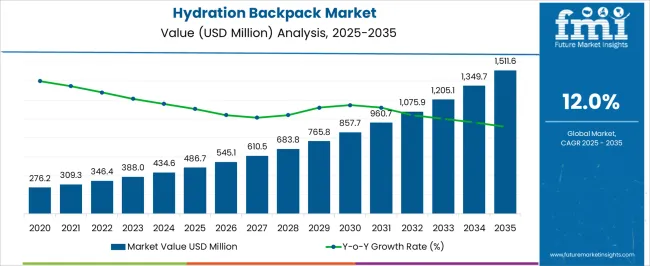
| Metric | Value |
|---|---|
| Hydration Backpack Market Estimated Value in (2025 E) | USD 486.7 million |
| Hydration Backpack Market Forecast Value in (2035 F) | USD 1511.6 million |
| Forecast CAGR (2025 to 2035) | 12.0% |
The hydration backpack market is expanding steadily due to rising consumer interest in outdoor recreational activities, endurance sports, and health conscious lifestyles. Increased participation in trekking, cycling, running, and adventure races has significantly contributed to the demand for hands free hydration solutions.
Consumers are increasingly prioritizing functionality, lightweight design, and durability when choosing hydration gear. Technological improvements in hydration reservoir materials, ergonomic strap systems, and anti microbial linings have also enhanced product performance and safety.
Furthermore, awareness around proper hydration for athletic performance and general wellness is boosting demand across both professional and amateur user bases. With product visibility growing across online and offline retail platforms, the outlook for this market remains positive as innovation and lifestyle trends continue to reinforce hydration backpack adoption across age groups and geographies.
The market is segmented by End-user and Distribution Channel and region. By End-user, the market is divided into Sports and Military. In terms of Distribution Channel, the market is classified into Specialty Stores, Departmental Stores, and Online Retail. Regionally, the market is classified into North America, Latin America, Western Europe, Eastern Europe, Balkan & Baltic Countries, Russia & Belarus, Central Asia, East Asia, South Asia & Pacific, and the Middle East & Africa.
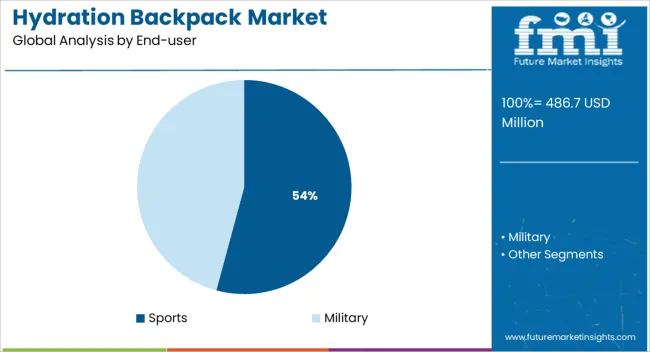
The sports segment is anticipated to contribute 54.20% of total market revenue by 2025, positioning it as the leading end user category. This dominance is being driven by increasing adoption of hydration backpacks among athletes, fitness enthusiasts, and recreational adventurers.
The ability to hydrate without interrupting physical activity is especially valued in endurance sports such as cycling, trail running, and mountain biking. Lightweight construction, enhanced back ventilation systems, and high capacity hydration bladders have made these backpacks ideal for prolonged outdoor activities.
Additionally, partnerships between hydration gear manufacturers and sports organizations are strengthening visibility and brand trust in this segment. The alignment of hydration backpacks with active lifestyles and performance optimization has established sports as the dominant end user in this evolving market landscape.
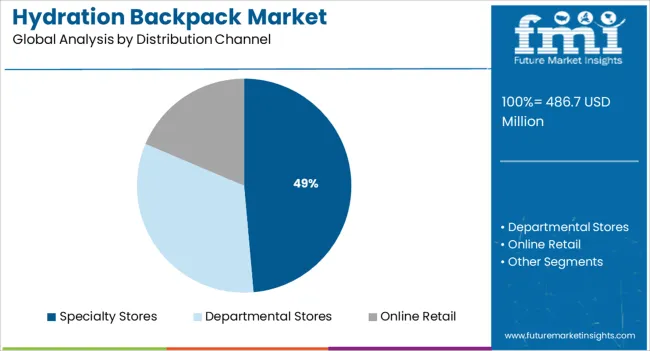
Specialty stores are projected to account for 48.60% of total market revenue by 2025 under the distribution channel category, making it the most prominent channel. This preference is driven by the ability of specialty retailers to offer expert guidance, product trials, and access to high quality performance gear.
Customers purchasing hydration backpacks often seek personalized recommendations and prefer to evaluate product fit, comfort, and storage capacity before making a purchase. Specialty stores also play a crucial role in educating consumers about features such as bladder volume, cleaning systems, and ergonomic designs.
Moreover, premium brands frequently launch their latest collections through these dedicated retail outlets to enhance positioning and maintain exclusivity. The hands on service experience and product expertise available through specialty stores has reinforced their leadership in the distribution strategy for hydration backpacks.
According to market research and competitive intelligence provider FMI, the hydration backpack industry grew at a CAGR of 11.6% from 2020 to 2025. Demand for military hydration products will be driven in the future by a combination of long-term durability, high performance, and high reliability for the products. With the advent of new technologies and advancements in materials, the backpack and luggage bags industry will continue to innovate, which will contribute to the growth of the market.
As one of the most popular outdoor sports gear in the coming years, hydration packs are expected to witness a surge in demand, allowing users to transport liquids without using their hands. Water dispensing systems allow consumers to easily dispense water from them without having to remove their backpacks or remove them while performing certain operations. High demand for sports activities is expected to increase in the coming years due to the popularity of sports activities and the possibility of spending less time at work.
In the wake of the recent pandemic, the world has returned to normalcy and consumers are choosing to make their lives more active. This trend is only going to increase in popularity in the future. Further, due to the substantial increase in defense expenditures across the globe, it is anticipated that new products will be introduced in order to meet the demands of fresh water for soldiers.
This is due to the substantial increases in defense expenditures across the globe. In addition to preventing chronic ailments, these products also assist in reducing the number of medicines consumed, as well as improving the overall well-being of users.
The Popularity of Outdoor Activities is Expected to Boost Demand for Hydration Backpacks
Increasing demand for adventure outdoor activities, a major driving force behind the global hydration backpack market, has contributed substantially to the market development. Sporting activities have been growing in popularity across the globe as consumers have become more interested in leisure activities as part of their busy lives and as a way to reduce stress in their busy lives.
The increasing awareness of hydration while performing activities and hiking instructions has also contributed to the growth of the market. Due to their busy schedules and health concerns, people turn to adventure activities like hikes, treks, cycling, and skiing to escape their stress. In addition, the growth of the global economy and the increase in disposable income will make it easier for established as well as emerging economies to invest more in tourism and events globally.
The increasing trend of e-tailing offers an array of opportunities that are changing the face of e-commerce. The increased interest from consumers presents a significant opportunity for key players to increase revenues and expand their geographic reach. Through social media and listing their products in a variety of marketplaces, several companies have successfully reached a broader consumer base in the market. Backpack and luggage bag manufacturers are enthusiastic about boosting the visibility of their products across regions in order to distinguish themselves from their competitors. Internet penetration is growing significantly, which offers them an excellent opportunity to reach their audience in the market.
Technological Advancement to Drive the Hydration Backpack Market Growth
As more and more body mapping technologies are employed along with ventilation in hydration backpacks, it is forecast that the hydration backpack market will experience steady growth in the coming years.
Additionally, manufacturers are offering hydration backpacks with integrated hydration compartments, vapor-barrier liners, and reflective closed-cell insulation to keep water cold for up to four hours. Aside from that, manufacturers are now also emphasizing the development of transparent hydration backpacks designed to meet the needs of a variety of end users around the globe
While it may sound easy, setting up and cleaning hydration packs during events can be quite a challenge. To access the reservoirs, participants will have to take off their gear, unhook their packs, fill them with water, and wash the packs with cleaning tablets. In the recent development of these packs, soft plastic materials may eventually break down and leak under critical conditions. In the coming years, military hydration products may struggle to succeed due to their nontransparent structure, which may impede sales of hydration backpacks in the coming years.
A lack of disposable income and high prices of hydration backpacks are likely to hamper the market growth in developing nations. As part of the forecast analysis, global brands will also be examined for presence and availability, and the challenges they face due to increased or reduced competition from national and international brands. As well as looking at international trade routes and domestic tariffs, we will also examine the impact of domestic tariffs.
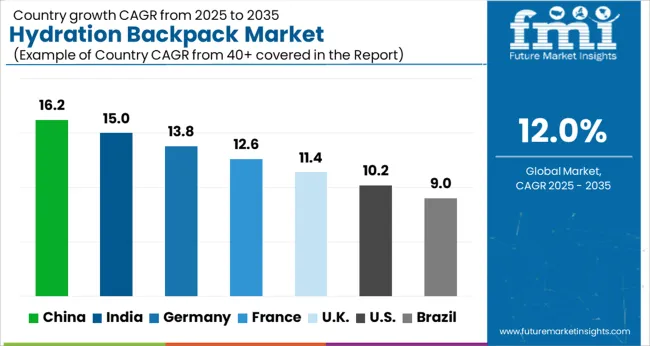
Growing Sports Outlets and Product Visibility in the Region contribute to Growth
The North American market is expected to be the top market for hydration backpacks through the forecast period, accumulating a revenue share of 41% over the forecast period. USA and Canadian adventure sports destinations are driving the market. With increased Research and Development investment, many new hydration backpack products are now being developed, which is expected to boost the growth of the North American hydration backpack market.
Also, improved visibility of products and the well-established sports industry will fuel demand for the products in the future. Moreover, the sporting goods retail outlets of major manufacturers as well as technological advancements led to major changes in the sports industry.
The popularity of outdoor activities across the region has boosted the demand for hydration backpacks, especially hiking hydration backpacks in this region. Hydration backpacks tend to gain wide acceptance because they help outdoors enthusiasts drink enough water while they are active. All these factors are expected to grow the market for hydration backpacks in the coming years.
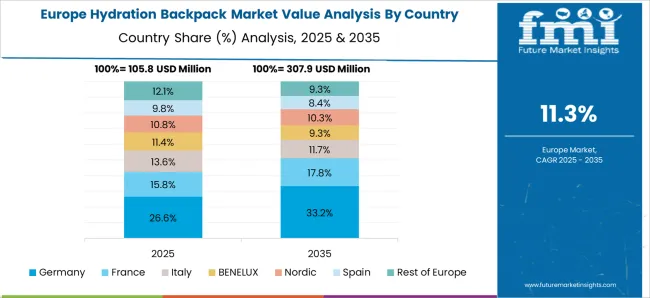
Governing Support and Demand for Military Products in Europe to Boost the Market Growth
Europe is expected to remain the market leader in hydration backpacks through 2025. European hydration backpack market share currently stands at 38% of the global market share. In addition, governments are continually implementing a plethora of initiatives, ensuring that they are constantly developing cutting-edge equipment for the military. As a result of the increased purchases of sports equipment by the United Kingdom, Germany, and France, the market is expected to strengthen the market for hydration backpacks in the coming years.
Among all the countries with military hydration backpacks, the United Kingdom is the most progressive when it comes to adopting new technologies and facilitating their rapid adoption of them. In addition, European military products enjoy government support, which allows them to dominate the market. Several key market players continue to invest in hydration backpack development initiatives that are expected to fuel global demand.
Growing demand for Hydration Backpacks will Broaden Future Growth Prospects
Hydration backpacks dominated the Asia Pacific market with a revenue share of 15% and will continue to do so in the coming years. Several countries, such as China, India, Japan, and South Korea, are focusing their efforts on the production of these bags, which will further increase the market for hydration backpacks. Market growth is expected to continue in the coming years as the population grows, lifestyles become more prevalent, disposable incomes increase, and different styles and innovations develop.
In recent years, hydration backpacks have gained popularity among hikers and biking enthusiasts, contributing to the market's growth. The market growth for these bags has also been driven by social trends as well as celebrity endorsements, which have contributed to the growth of this market.
Growing demand for hydration backpacks that have different sizes and liter capacities in this region is expected to drive the growth of the hydration backpack market in this region in the near future. Additionally, the growing trend of e-tailing will further contribute to the growth of the market in the future.
Military Segment Generates High Revenue in the Hydration Backpack Market
Based on end users the market is segmented into sports and military segments. According to projections, the military market for hydration backpacks will grow at a CAGR of 4.5% by 2035. Military hydration products are projected to gain popularity during the evaluation period due to advances in new technologies, such as high-resolution liquid crystal displays (LCD) screens on water bottles that can provide on-the-go functionality. In addition to the military's increased use of these products, primarily for training purposes, market growth is also expected to increase.
As soldiers throughout the world are expected to employ these products in a variety of training exercises which might involve sprinting, running with heavy loads, or marching over a long distance in a series of events, usually involving short sprints, these products provide essential support. With the increasing demand for hydration packs among military personnel, there is an increased preference for these products in the form of their capacity to hold a great deal of water, compared to other types of products.
In the coming years, military hydration products market growth may be accelerated as concerns about health and safety in the military and defense industry grow. Various countries around the world are increasing their defense expenditures, and it is expected that this will lead to an influx of products that will provide fresh water to soldiers.
Growing E-commerce Websites are expected to Drive Hydration Backpack Sales
FMI forecasts that online retailers will record the highest CAGR for hydration backpack sales during the forecast period. Further, the increasing number of smart screens and the wide availability of brands and products in the market are likely to further contribute to the growth of the market. Online shopping experiences have been improved by major companies like CamelBak, Jack Wolfskin, and Gregory to enhance sales of these products.
E-commerce has gained popularity over the past few years, mainly due to the convenience that it provides when it comes to shopping with easy access through the internet. Increasingly, buyers across the world are switching from brick-and-mortar to online shopping due to the convenience of having everything at their fingertips has added to the growth of this market. The market is currently flooded with a considerable number of niche players promoting high-quality hydration backpacks for a wide variety of activities and sports.
What Contribution do New Entrants Make to the Hydration Backpack Market?
In an effort to meet consumers' needs, startups are now entering the hydration backpack market. Additionally, these innovative backpack companies offer athletic activity-specific hydration backpacks with additional features and durability. There are several start-up companies now focusing on developing leakproof backpacks and splashproof products for the market.
Some of the start-ups in the hydration backpack market include-
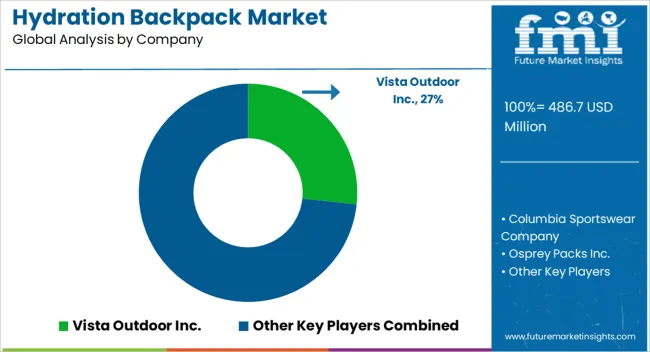
By increasing production and meeting consumer demand through strategic partnerships, manufacturers can increase revenues and gain a greater share of the market. Through the adoption of hydration backpacks, users will be able to benefit from new products and technologies. Through strategic partnerships, production capabilities can be expanded.
Key players in the global hydration backpack market include Vista Outdoor Inc. (CamelBak), Columbia Sportswear Company, Osprey Packs Inc., High Sierra, Gregory Mountain Products, Source Tactical Gear, Hydro Flask, Mazama Designs, LLC., USWE Sports AB, and TETON Sports.
| Report Attribute | Details |
|---|---|
| Growth Rate (2025 to 2035) | 12% |
| Expected Market Value (2025) | USD 486.7 million |
| ProjectedForecast Value (2035) | USD 1511.6 million |
| Base Year for Estimation | 2025 |
| Historical Data | 2020 to 2025 |
| Forecast Period | 2025 to 2035 |
| Quantitative Units | Revenue in USD Million and CAGR from 2025 to 2035 |
| Report Coverage | Revenue Forecast, Volume Forecast, Company Ranking, Competitive Landscape, Growth Factors, Trends, and Pricing Analysis |
| Segments Covered | End User, Distribution Channel, Region |
| Regions Covered | North America; Latin America; Europe; Asia Pacific; Middle East & Africa |
| Key Countries Profiled | USA, Canada, Brazil, Mexico, Germany, United Kingdom, France, Spain, Italy, China, Japan, South Korea, Singapore, Thailand, Indonesia, Australia, New Zealand, GCC Countries, South Africa, Israel |
| Key Companies Profiled | Vista Outdoor Inc. (CamelBak); Columbia Sportswear Company; Osprey Packs Inc.; High Sierra, Gregory Mountain Products; Source Tactical Gear; Hydro Flask; Mazama Designs, LLC.; USWE Sports AB; TETON Sports; GenZ Outdoor; Whipsaw |
| Customization | Available Upon Request |
The global hydration backpack market is estimated to be valued at USD 486.7 million in 2025.
The market size for the hydration backpack market is projected to reach USD 1,511.6 million by 2035.
The hydration backpack market is expected to grow at a 12.0% CAGR between 2025 and 2035.
The key product types in hydration backpack market are sports and military.
In terms of distribution channel, specialty stores segment to command 48.6% share in the hydration backpack market in 2025.






Full Research Suite comprises of:
Market outlook & trends analysis
Interviews & case studies
Strategic recommendations
Vendor profiles & capabilities analysis
5-year forecasts
8 regions and 60+ country-level data splits
Market segment data splits
12 months of continuous data updates
DELIVERED AS:
PDF EXCEL ONLINE
Hydration Supplement Market Outlook by Product Type, Application, Sale Channels and Others Through 2035
Hydration Boosters Market – Growth, Functional Beverages & Industry Demand
Hydration Infusers Market
Dehydration Monitoring Systems Market Growth – Trends & Forecast 2025 to 2035
Military Hydration Products Market Growth - Trends & Forecast 2025 to 2035
Intravenous Hydration Therapy Market Size and Share Forecast Outlook 2025 to 2035
Gas Desiccant Dehydration Unit Market Size and Share Forecast Outlook 2025 to 2035
Liquid Desiccant Natural Gas Dehydration Unit Market Size and Share Forecast Outlook 2025 to 2035
Backpack Systems Market Size and Share Forecast Outlook 2025 to 2035
Backpacker Gears Market Analysis - Size and Share Forecast Outlook 2025 to 2035
Daily Backpacks Market Size and Share Forecast Outlook 2025 to 2035
Smart Backpack Market Size and Share Forecast Outlook 2025 to 2035
Hiking Backpacks Market Analysis - Trends, Growth & Forecast 2025 to 2035
Bicycle Bags and Backpacks Market - Trends, Growth & Forecast 2025 to 2035

Thank you!
You will receive an email from our Business Development Manager. Please be sure to check your SPAM/JUNK folder too.
Chat With
MaRIA